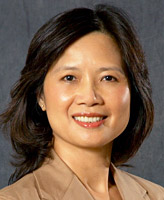By Aaron Mays
This year's historic U.S. presidential election generated a media frenzy since John McCain and Barack Obama began their campaigns. Amid the election ads, presidential debates and Saturday Night Live parodies, recent studies by Kellogg School faculty reveal a more complex story about the political landscape, one that involves rhetorical skill, voter identity and racial attitudes.
Battle of words for the public ear
Great orators employ rhetoric to communicate a message that captures the crowd's imagination. These oratory traditions date to Aristotle and Plato, but while the basics of classical rhetoric remain true, today's presidential hopefuls convey their ideas through an array of powerful strategic channels.
But timely messages prove critical too, says Angela Lee, the Mechthild Esser Nemmers Professor of Marketing. Her research, "It's Time to Vote: The Effect of Matching Message Orientation and Temporal Frame on Political Persuasion," examines the persuasiveness of political campaigns based on when voters receive the message.
"A political campaign is different from an ad for a brand of product or service," says the Kellogg professor. Unlike advertising for consumer products, "a campaign has an important date: Election Day."
In a forthcoming issue of the Journal of Consumer Research, Lee and her co-authors examine political messages based on what psychologists term construal level theory: abstractness (high-level thinking) or concreteness (low-level thinking). According to the theory, how people think is highly correlated with when they have to make a decision.
 |
|
| Professor Angela Lee |
|
| |
|
 |
|
| Professor Adam Galinsky |
|
| |
|
 |
|
| Professor Katherine Phillips |
|
| |
|
"Events scheduled to occur in the distant future prompt people to think in more abstract terms, while an event in the near future prompts people to think more concretely," she explains. "A year before the election, people are more likely to think in abstract terms. When the election is tomorrow, voters are more likely to think in concrete terms."
Early in his campaign, Obama highlighted "the desirability of the outcome, which is more high-level, than the feasibility of his strategy," Lee says. His message of change and hope received some criticism for lacking details; however, Lee's findings suggest Obama's message was an advantageous strategic move in the early stage of the political race.
"A campaign that deals with the high-level ideas when the election is far away would be much more persuasive," Lee says. "At that time, no one cares about 'how' these ideas would become reality through policy decisions."
As Election Day nears, she says, the content of political messages should shift from lofty goals to a detailed, executable plan. "Timing isn't everything, but it does make a difference."
The people's choice
While soaring rhetoric has potential political power, it only assumes that power by tapping into the public's aspirations. Adam Galinsky, the Morris and Alice Kaplan Professor of Ethics and Decision in Management, has explored how race may influence voters' choices.
Galinsky says that most people identify themselves via affirmational statements, such as I am a woman or I am a Republican. But one's identity does not stem solely from these positive declarations. Statements such as I'm not white or I'm not a Democrat reflect identity as a negational identification, a term that Galinsky and his team, including Kellogg Associate Professor of Management and Organizations Katherine Phillips, coined in "Negational Racial Identity and Voting Preferences." The research will appear in a forthcoming issue of the Journal of Experimental Social Psychology.
Negational identity is a powerful motivator and "an equal and important meaningful source of social identity," Galinsky says. "It's not only about who you are but who you are not."
Galinsky and co-authors explored this concept and its election implications.
"Early on, there was clear evidence that the election started to divide along racial lines, with Latinos and Asians showing a much stronger preference for Hillary Clinton compared with the responses of other groups," he says.
Galinsky and his colleagues conducted two experiments before the U.S. primary elections. In one experiment, 38 Latino students were asked to write about being Latino. Among the students who reported being Latino, 26 percent preferred Obama, 58 percent preferred Clinton and three were uncommitted. Another group was asked to write about their experiences of not being white. In this group there was a dramatic change: 58 percent preferred Obama and 37 percent preferred Clinton while one was uncommitted. Another experiment with Asian students produced similar results.
Overall, Galinsky explains this outcome by saying that when people shift their focus from "who they are" to "who they are not," their preferences change. "When people are thinking about their identity as Asian or Latino, it makes them feel less connected to and lend less support to an African-American candidate."
Promoting a non-white identity among the Latino and Asian populations can be a way to increase votes, but that same strategy might damage efforts to woo white voters. Obama's campaign tried to avoid the issue of race, but it occasionally surfaced. Being the first leading African-American contender for the White House, Obama's candidacy sparked a dialogue about race in America.
Professor Phillips believes such conversations are relevant. "It's harder for some people to see Barack Obama in the leadership role as President of the United States," she says.
Galinsky says that among people in power, personality traits and actions can either "violate or confirm stereotypes of a leader." One of those traits is race and it plays a powerful part.
A new leadership standard
Exploring how race is perceived in the context of leadership, Phillips and her co-authors produced "The White Standard: Racial Bias in Leader Categorization," published in the July Journal of Applied Psychology. When a leader possesses traits consistent with a leadership standard, they found, that person is deemed more effective. When race is added to those criteria, though, non-white leaders are evaluated less favorably than their white counterparts.
"People have a schema of what a leader is and what the characteristics of a leader should be," says Phillips, who is co-chair of the Kellogg Center on the Science of Diversity.
Previous studies show that people see a prototypical leader's characteristics as overlapping with male stereotypes. In her research, Phillips explored leadership's racial dimension and found that most of the study's participants also assumed a leader to be white. Participants evaluated white leaders as more successful and credited them more often for successes. This bias creates a double standard for non-white business leaders, Phillips says, making it more difficult for them to prove themselves and less likely to be given a second chance.
Obama, she says, presents a leadership model that is atypical compared to those that voters have previously endorsed.
"Obama may have to deal with this bias when people evaluate what he does and how he does it," she says. "He will continually have to win people over." To surmount this white leadership standard, President-elect Obama must keep highlighting his strengths to clear any doubt about his ability.
As for McCain, he fit the traditional U.S. presidential leadership model, Phillips says, and the white standard worked to his benefit, especially with his military credentials. However, Phillips says McCain had to confront other factors that are at odds with the dominant leadership schema, such as his age.
Phillips emphasizes that there are leaders who don't have all the prototypical characteristics but says that the white standard is likely to remain a key factor.
"The white standard is not going away overnight," she says. "The hope is that one day this standard will not have such a strong impact on people."
|



